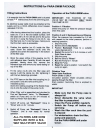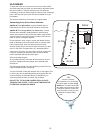POOL HEATING
Pool heating can be achieved using gas- natural and propane, oil, heat pump, heat exchanger- utilising your existing house
boiler, electric or solar panels.
Gas Heaters. By far the most popular form, where natural gas is available, are direct fired natural gas heaters. These
specifically designed and manufactured for swimming pools, they are practical, clean and efficient. Heaters are available for
both indoor or outdoor ‘flueless’ installations, outdoor types are popular because there is no need for unsightly flue
chimneys. A simple thermostat controls pool water heating.
Where propane gas heaters are installed invariably a gas tank has been sited and a contract has been made with a bulk
supplier for regular top-ups of gas.
Be aware that whilst these heaters are suitable for outdoor installation all heater cases can be ‘hot’ and should have some
barrier protection against contact with bare skin.
Oil Heaters. Invariably in country areas you will be using domestic fuel oil. Oil pool heaters can be ‘direct’, indoor or out
conventional flued or ‘indirect’ pressurised sealed systems, again available either conventional or balanced flued.
Direct oil fired heaters are controlled by a simple thermostat. Indirect pressurised sealed systems have two thermostats,
one controlling the primary hot water temperature and one for the pool water temperature.
Heat Pumps. These units are generally installed where there is no gas and oil is impractical due to distances from tank
to heater. Heat pumps run off of electricity and basically operate like a fridge in reverse, they draw warm fresh air over a
refrigeration system, the heat chilled from the fresh air, together with all the electrical energy consumed in operating the
system is transferred via an integral heat exchanger to your pool water.
Heat pumps are considered to be super efficient and simple to install, however be aware that they will put heat into your
pool water very slowly, typically it may take up to 2 weeks continuously running in the spring to achieve your desired
temperature. Again in the autumn they may need to be run continuously depending on ambient temperatures.
Heat Exchanger (Calorifier). Where possible and practical a heat exchanger may be fitted to your existing house
boiler and is simply another circuit i.e. a normal house system has one circuit for hot water and one for central heater, add
a heat exchanger and you have a third.
Invariably your central heating programmer will have been changed and an additional primary hot water circulating pump
will have been installed.
Electric Heating. Usually installed on smaller pools where there is no other source of heat or as heater ‘boost’ on
pools with heat pumps or solar.
Electric heaters can be run on ‘off-peak’ with an over-ride if required and simple thermostat controls pool water heating. (Be
aware that the time will need re-setting in the event of a power cut!)
Solar Heating. Solar heating panels are usually sited on a south or southwest facing roof or garden area near to the
pool. Filtered pool water is diverted through these panels thus picking up any solar gain available.
Differential thermostats operating a motorised valve to ensure efficient running and to maximise solar gain control Solar
heating.
When winterising your pool always remove the solar cover, clean it and allow it to dry. If left on the pool in icy conditions the
cover life will be greatly reduced.
SOLAR COVER ROLLERS (REEL ASSEMBLIES)
Although it is possible to cope with a solar cover by hand, it is a lot easier to remove and replace the cover with the aid of a
solar cover roller.
WINTER DEBRIS COVERS
A winter debris cover fitted to your pool will keep out the vast majority of leaves, twigs etc. whilst the pool is closed. Above
ground winter covers are usually 1’-1’6” larger in each direction than the actual pool size and is held in place by means of
a draw cord and ratchet.
The cover should lay on top of the pool water, once fitted run 1”-2” of water onto the top of the cover to keep it place, it is
worthwhile to check for strap tension from time to time and adjust if required.
17


















